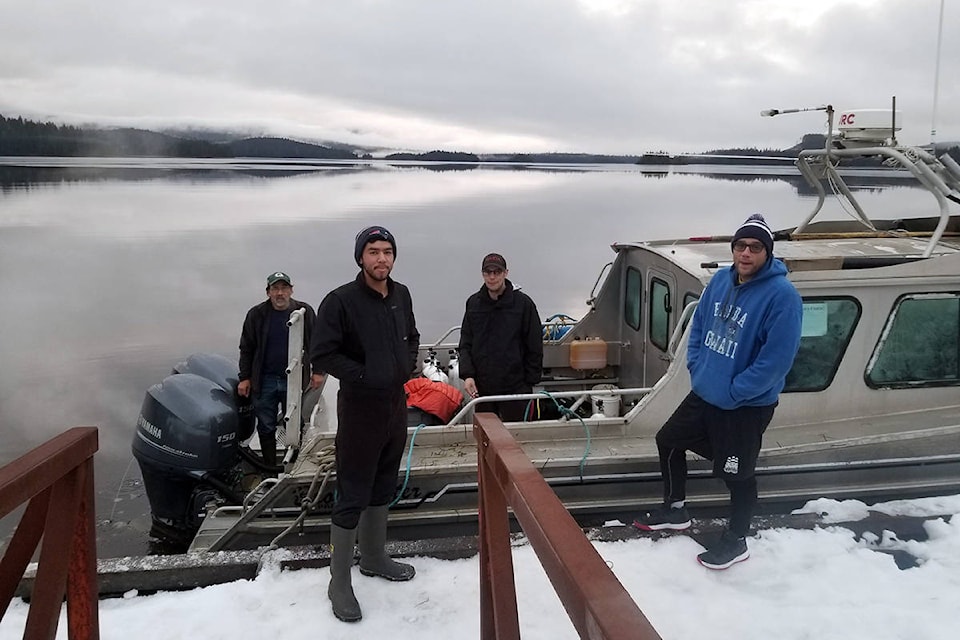Work has begun to revitalize marine habitat around an old logging site near Port Clements.
Judson Brown, marine planning program manager for the Council of the Haida Nation (CHN), told the Observer work started around January on a three-year project that includes a pilot to restore the old logging site at Juus Káahlii Juskatla Inlet, where harvested tree logs used to be dumped into the ocean and loaded onto barges.
According to a release from the CHN on June 9, about 20 trucks were processed each day at the Juskatla Inlet pilot site during peak logging years, from the 1960s to about 1980.
Loggers would dump logs into the water at the end of a causeway, where they also dug a hole to keep wood from hitting the seafloor. Infill from the hole and other woody debris was routinely piled on the surrounding beach, including on top of a t’anuu eelgrass meadow, believed to have supported a vibrant fish nursery.
Bacteria use oxygen when breaking down debris underwater, so the site has since become a more severe, anoxic environment compared to its natural state — a subtidal “dead zone” where other marine organisms struggle to survive.
Ultimately, the CHN hopes to restore a marine meadow the size of 10 to 20 basketball courts (0.4-0.8 hectares).
“It’s going to look way different,” Brown said. “This project is pretty much the first of its kind on the B.C. coast.”
ALSO READ: Commercial fishing concerns over marine protected areas
Biologist Leandre Vigneault, owner of the Marine Toad company that has been contracted to manage the project, told the Observer the pilot site is unique since it is far inland from the ocean. Set behind two narrow passages, there is limited natural flushing of the water in the area, lower salinity, high tannin concentrations and a relatively less diverse ecosystem.
Vigneault has been participating in the dives done to date and although they happen during the day, he said if he did not have his own light below 25 feet “it might as well have been midnight.”
Eelgrass needs a low, gently-sloping zone where light can penetrate to grow, so he said his crew will be digging and pulling back the material deposited over the eelgrass beds with excavators, re-establishing the natural beach contours over the summer, and then transplanting eelgrass from the neighbouring bay over the fall and winter.
“The exact timing will depend on COVID-19 considerations and obtaining all of the permits required for the various activities,” he said.
ALSO READ: Marine protected areas not all good, says Vancouver Island fisherman
The Juskatla Inlet site was chosen from a list of 69 historic log sorts around Haida Gwaii to be the pilot site for the larger marine habitat restoration project, which aims to improve habitat under and around past and current log sorts, booming areas, and other areas impacted by logging and related activities.
Fisheries and Oceans Canada announced on March 10 that the Secretariat of the Haida Nation was receiving more than $1.1 million over three years for the project.
The funding was part of the final call for proposals under the $75 million Coastal Restoration Fund, which has provided or approved funding for 64 partnered projects since it was announced by the federal government in May 2017.
The Coastal Restoration Fund is in turn part of the five-year, $1.5 billion Oceans Protection Plan. Launched in November 2016, the plan is the largest investment ever made to protect Canada’s coasts and waterways.
ALSO READ: Marine experts investigating after first recorded striped dolphin sighting on Haida Gwaii
Other historic log sites on Haida Gwaii are also being considered for restoration in 2021 as part of the overall project, such as the portion of Bearskin Bay in Skidegate Inlet that is no longer used for logging.
Vigneault said the Bearskin Bay project could possibly focus more on re-establishing kelp.
For example, the crew may sprinkle rocks with kelp larvae attached on the seafloor.
He said they will be monitoring the success of all project restoration work over the short and long-term.
ALSO READ: SG̱aan Ḵinghlas-Bowie Seamount marine area receives renewed protection
Do you have something to add to this story or something else we should report on? Email:
karissa.gall@blackpress.ca.
